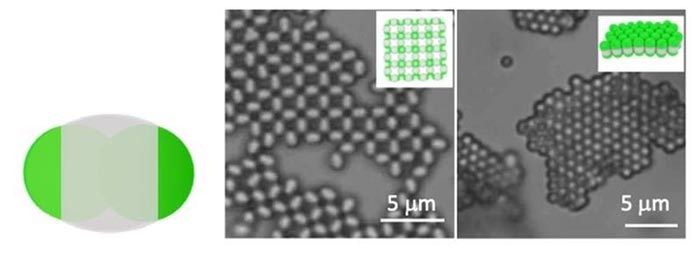Making designer crystals?

Schematic of a particle with distinct regions (left). The bright-field fluorescent images (center and left) and schematics (inserts) show selective crystallization via pole-to-pole or center-to-center interactions. Scale bars are 5 microns.
Image courtesy of David Pine, New York University
It’s easier with a new targeted particle bonding strategy.
The Science
Colloids are microparticles in a solution, meaning the particles are evenly distributed. Crystals made from colloids are valuable in a wide range of applications such as batteries, fuel cells, sensors, solar cells, and catalysts. Scientists have sought ways to assemble these crystals into larger structures using bonding methods that operate in targeted directions. However, this approach is quite challenging. A new strategy exploits the ability to create precise regions with specific chemical and physical properties on the surface of the crystal particles. Scientists can use selective interactions between these regions on different particles to direct the formation of the crystal structure.
The Impact
This strategy is a powerful approach for programming the assembly of particles with desired geometry and properties. The strategy has several key benefits. It avoids the need for costly and complex chemical surface engineering. It can construct materials ranging from simple chains to membrane-like structures. It can also readily tune materials’ properties and structures without having to create a new material from scratch each time.
Summary
Colloidal crystals are commonly formed from a mixture of large and small particles. Attractive forces between the larger particles push the small particles away. The larger particles squeeze together into tighter and tighter packings that eventually lead to crystal formation. The composition of the smaller particles influences this squeezing process. Scientists have suggested that it is theoretically possible to use these forces to selectively position non-spherical particles within a crystal lattice by creating surface patches. However, scientists had not realized this possibility. Now, researchers have developed a process for building hybrid particles composed of distinct polymer regions. In this process, tuning the surface charges on the particles favored interactions between certain regions. This enabled a specific region of one particle to interact selectively with the same region on neighboring particles. The researchers used these interactions along with particle size and shape to control the bonding angles among particles and consequently the structural features and properties of the resulting crystals. The researchers observed the simultaneous formation of crystals with different structures in real time using advanced microscopy and computational methods. These interactions are reversible. This approach potentially allows straightforward reconfiguration of crystal properties and switching between crystal structures.
Funding
This work was supported through funding from Department of Energy Office of Science. Partial support for one of the researchers was provided by the Donors of the American Chemical Society Petroleum Research Fund. The Zeiss Merlin field emission SEM was acquired through the support of the National Science Foundation.
Journal: Nature Materials
DOI: 10.1038/s41563-020-0744-2
Method of Research: Experimental study
Subject of Research: Not applicable
Article Title: Tunable assembly of hybrid colloids induced by regioselective depletion
Article Publication Date: 27-Jul-2020
Media Contact
Michael Church
DOE/US Department of Energy
michael.church@science.doe.gov
Office: 2028416299
All latest news from the category: Materials Sciences
Materials management deals with the research, development, manufacturing and processing of raw and industrial materials. Key aspects here are biological and medical issues, which play an increasingly important role in this field.
innovations-report offers in-depth articles related to the development and application of materials and the structure and properties of new materials.
Newest articles

Innovative 3D printed scaffolds offer new hope for bone healing
Researchers at the Institute for Bioengineering of Catalonia have developed novel 3D printed PLA-CaP scaffolds that promote blood vessel formation, ensuring better healing and regeneration of bone tissue. Bone is…

The surprising role of gut infection in Alzheimer’s disease
ASU- and Banner Alzheimer’s Institute-led study implicates link between a common virus and the disease, which travels from the gut to the brain and may be a target for antiviral…

Molecular gardening: New enzymes discovered for protein modification pruning
How deubiquitinases USP53 and USP54 cleave long polyubiquitin chains and how the former is linked to liver disease in children. Deubiquitinases (DUBs) are enzymes used by cells to trim protein…



